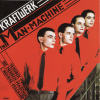小简介
70年代中期,德国的 Kraftwerk 乐队勾勒了以后十几年中无数电子音乐家竭力追随着去实现的宏伟蓝图。从英伦 New Wave 运动到 hip-hop 再到 techno,乐队自己形容的“机器人流行乐”(用电子设备表现出的有催眠节奏的音乐)在电子音乐的每个新的发展阶段都产生了巨大的反响,深刻地影响着20世纪末同时代的流行乐。作为电子乐先锋,他们持久深远的影响无论怎样形容都不嫌夸张。
Kraftwerk 是从60年代末的德国实验音乐团体中脱颖而出的,这个团体也孵化了像Can和 Tangerine Dream 这样的著名乐队。乐队核心成员 Florian Schneider 和 Ralf Hutter 首次相遇时还是西德一所古典音乐学院的学生。他俩起初在一个叫 The Organization 的五人乐队里,1970年乐队发行了专辑 《Tone Float》。接着 Schneider 和 Hutter 就解散了 Organisation,重新组建了自己的乐队并命名为 Kraftwerk(德文意思是“发电站”),开始在他们自己的工作室(后来称为“King Klang”)里制作起了音乐,沉浸在他用最低限度要求电子学创作的还不是很成熟的音乐中。他们1971年的首张专辑 《Kraftwerk 1》,提出了他们独特美学观点的早期雏形,并进行了一些创新的尝试,包括其中用到的由 Schneider 自己设计制作的电子设备。专辑中怪异机械的噪音处理和环境电声操作让当时的乐坛大吃一惊。
接下来的是一系列的人员变换,甚至 Hutter 也一度离开了乐队。但是,到发行专辑 《Kraftwerk 2》 时, Hutter 又回来和 Schneider 一起工作了。这张录音没有用鼓,专辑的节奏部分全部由鼓机来提供,创造出了在那时还没有先例(从纯技术概念来看)的具有明显机械感的音乐,彻底地与传统音乐家背道而驰(正如当时的听众)。然后乐队举办了一些颇受欢迎的现场演出,直到他们第三张具有突破性的专辑,1973年的《Ralf and Florian》的发行。专辑把他们的野心和抱负精炼成一些简单但极有革新理念的动机,他们的音乐变得越来越具有启发性——尽管他们这种轮廓鲜明、科学的形象是完全处在那个时代流行音乐的对立面。
Kraftwerk 在美国发行的第一张专辑,1974年的 《Autobahn》 获得了国际上的巨大成功。标题曲 “Autobahn” 长达22分钟半,剪辑后的单曲版在人们的家里和旅途中处处可闻。在美国这支先前不为人知的乐队却冲上了流行音乐专辑排行榜且居高不下。大部分用穆格电子合成器演奏的第一首序曲打破传统流行音乐的结构和旋律的同时,《Autobahn》 确立了独特的 Kraftwerk 之声。从这张专辑开始,Kraftwerk 便从 Krautrock 中蜕变到了纯电子音乐领域,并成功地闯入了流行音乐界,使电子音乐在主流音乐中找到了永久的立足点。
1975年 Kraftwerk 以一张探讨无线电通讯题材的概念专辑 《Radio—Activity》 再次露面,专辑发行了德文和英文两个版本,预示了乐队在世界范围的流行。
火车旅行是1977年的专辑 《Trans—Europe Express》 的主题,标志着音乐向机械化方向发展的运动正在兴起。《Trans—Europe Express》 对早期的 Hip-hop 产生过重大影响,它把一种比较冷酷严厉的节奏和胆怯神秘的高音调散射结合到了一起,这种效果具有催眠作用。Kraftwerk 善于使用重复部分,这种效果就像是节奏中带有弹性效应。曲子 “Metal On Metal” 就像是吹来一股凉爽的微风。
1978年的专辑 《The Man Machine》 走得更远,在这张唱片里已完全失去了人类触觉。唱片封面的构图取自俄国结构主义大师 El Lissitzky 强硬的对角斜纹布局,它棱角分明的线条正符合 Kraftwerk 想表现的机器、动力等意想,乐队成员身着大红色的衬衫和漆黑色的领带,极富挑战性。这时,Kraftwerk 的成员甚至公开地称自己为机器人,开篇曲 “We Are the Robots” 更是巩固了这个形象。一曲旋律优美、典雅浪漫的 “The Model” 让人百听不厌。整张唱片的曲子结构严谨、编曲精细,乐队操纵起各种电子元素已是驾轻就熟,使这张专辑到达了 Kraftwerk 音乐事业的顶峰。
紧接着乐队便从人们的视野中消失了,经过长期的缺席后发行了他们1981年的专辑 《Computer World》,却没有回到先前的动机,而是针对计算机这一将在全球范围占据统治地位的新技术的沉思——他们的音乐很早就对人类的将来提出了预示。专辑中的单曲 “Computer Love” 冲上了英国流行音乐排行榜榜首,之后他们便又消失了。
沉寂了五年之久,1986年 Kraftwerk 推出了专辑《Electric Cafe》。这时,使用电子合成器和鼓机的流行音乐已经成了主流,乐队卓越的成就也使他们名垂青史。
1991年,Kraftwerk 发行了一张名为 《The Mix》 的重新混音精选辑。以后的几年乐队一直保持沉默,直到1999年末才发表了单曲“Expo 2000”。
回顾 Kraftwerk 的音乐历程,虽然到了后期乐队几乎没有发表什么新作品,但他们在现代流行音乐中的地位绝对是不可动摇的。从另一个角度来看,正是乐队这种寻求突破、不断创新的态度使其后来的音乐受到了限制,他们的完美主义精神为日后的创作设立了一个几乎不可能超越的标准。
Kraftwerk 在70年代中期的三张专辑 《Autobahn》、《Trans—Europe Express》、《The Man Machine》 无疑是乐队最成熟完美的作品。Kraftwerk 的电子音乐摆脱了冗长繁复的结构,采用了小巧、循环的节奏编排,听来极为流畅悦耳。这三张专辑在当时的传统音乐家看来是离经叛道,却震撼了无数有革新理念的实验音乐家,使他们从此改变了自己的音乐道路。New Wave、New Romantic、Ambient、Hip—hop、Techno 甚至工业噪音等音乐都从中得到了启发,音乐家们在 Kraftwerk 音乐思想的指引下层层突破,使得今天的电子音乐极为繁盛。也许不少人还没有听过这三张唱片,但现在人们听到的流行音乐却都渗透着 Kraftwerk 的艺术理念。
During the mid-70s, Germanys Kraftwerk established the sonic blueprint followed by an extraordinary number of artists in the decades to come. From the British new romantic movement to hip-hop to techno, the groups self-described robot pop — hypnotically minimal, obliquely rhythmic music performed solely via electronic means — resonates in virtually every new development to impact the contemporary pop scene of the late- 20th century, and as pioneers of the electronic music form, their enduring influence cannot be overstated. Kraftwerk emerged from the same German experimental music community of the late 60s which also spawned Can and Tangerine Dream; primary members Florian Schneider and Ralf Hütter first met as classical music students at the Dusseldorf Conservatory, originally teaming in the group Organisation and issuing a 1970 album, Tone Float. Schneider and Hütter soon disbanded Organisation, re-christening themselves Kraftwerk (German for power station), beginning work on their own studio (later dubbed Kling Klang), and immersing their music in the fledgling world of minimalist electronics; their 1971 debut, titled simply Kraftwerk 1, offered a hint of their unique aesthetic in its earliest form, already implementing innovations including Schneiders attempts at designing homemade rhythm machines.
A series of lineup shifts followed, and at one point Hütter even left the group; however, by the release of 1972s Kraftwerk 2, he and Schneider were again working in tandem. Recorded without a live drummer, the albums rhythms relied solely on a drum machine, creating a distinctly robotic feel without precedent — the concept of purely technological music was, at the time, utterly alien to most musicians, as well as listeners. A series of well-received live performances followed before Kraftwerk began work on their breakthrough third LP, 1973s Ralf and Florian; honing their many ambitions down to a few simple yet extraordinarily innovative concepts, their music began growing more and more revelatory — even their clean-cut, scientific image was in direct opposition to the dominant pop fashions of the time. Kraftwerks first album to be issued in the U.S., 1974s Autobahn was an international smash; an edited single version of the epic title track was a major hit at home and abroad, and in America the previously unknown group reached the upper rungs of the pop albums chart. Performed in large part on a Moog synthesizer, Autobahn crystallized the distinctive Kraftwerk sound while making the groups first clear overtures towards conventional pop structure and melody, establishing a permanent foothold for electronic music within the mainstream.
Kraftwerk resurfaced in 1975 with Radio-Activity, a concept album exploring the theme of radio communication; indicative of the groups new global popularity, it was released in both German and English-language editions, the latter appearing early the following year. Train travel emerged as the subject of 1977s Trans-Europe Express, which marked an increased movement towards seeming musical mechanization; the line became even further blurred with the follow-up, 1978s aptly titled The Man Machine, a work almost completely bereft of human touches. By this time, the members of Kraftwerk even publicly portrayed themselves as automatons, an image solidified by tracks like We Are the Robots. Having reached the peak of their influence, however, the group disappeared from view, the first of many extended absences to follow; they did not return to action prior to 1981s Computer World, a meditation on the new global dominance of technology — a society their music long ago predicted and pre-dated. After topping the British charts with the single Computer Love, Kraftwerk again vanished, enjoying a five-year layoff culminating in the release of 1986s Electric Cafe. By now, however, pop music was dominated by synthesizers and drum machines, and the groups stature flagged; but for a 1991 best-of collection titled The Mix, they remained silent during most of the decade. They finally released a new single, Expo 2000, in late 1999, and surprised fans by announcing tour dates. On the recording front, Kraftwerk celebrated the centennial anniversary of the Tour de France with a new version of their 1983 single Tour de France, and followed with a full album (Tour de France Soundtracks) in August 2003. The live record Minimum-Maximum followed in 2005.


